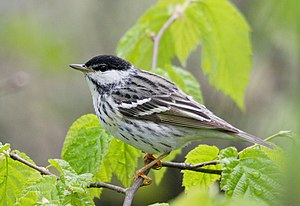Striped Warbler
| Striped Warbler | ||||||||||||
|---|---|---|---|---|---|---|---|---|---|---|---|---|

Striped Warbler, male |
||||||||||||
| Systematics | ||||||||||||
|
||||||||||||
| Scientific name | ||||||||||||
| Setophaga striata | ||||||||||||
| ( Forster , 1772) |
The striped wood warbler ( Setophaga striata , syn .: Dendroica striata ), also called cap wood warbler (rarely also monk or black cap wood warbler ), is a small monotypical songbird species from the genus of the wood warbler ( Setophaga ) in the family of wood warblers (Parulidae). It occurs exclusively in North America . The IUCN classifies it as safe ( least concern ).
Appearance
The bird reaches a body size of 13 to 15 centimeters. The wingspan is 20 to 23 centimeters. The weight varies between 10 and 16 grams.
In the breeding dress , male striped warbler wear a black cap, a black-striped white breast, a white head plumage and a brown upper side plumage with dark stripes. There are two white wing rods on each wing cover. Female warblers have a similar but duller plumage, and the crown and face are greyish. Outside the breeding season, the upper side plumage is greenish with dark stripes, the head greenish and the chest area yellowish. The rods on the wing covers are missing.
Distribution area
The breeding area is in the north of North America . The breeding area includes Alaska , Northern Canada, the Great Lakes, and New England . They spend the winter in South America . Some birds even reach southern Chile and Argentina during the migration. As a very rare guest, the wood warbler is also found in Western Europe .
Way of life
The warbler pecks insects and other invertebrates from the leaves in the upper branches of trees and shrubs. Fruits are also part of his diet to a lesser extent. Males indicate their territory with loud singing and try to attract females in this way. As a rule, they enter into a monogamous seasonal marriage. However, males with very good territories also mate with several females.
The nest is built on the ground from small twigs. The actual nesting trough is covered with lichen, grass and feathers. The clutch consists of three to five eggs. These are off-white or pale greenish with brown spots. The breeding season is eleven to twelve days. The female breeds alone. The male supplies the female with food during this time. The nestlings are fed by both parent birds and fledged after eight to ten days. They are fed by the parent birds for another 25 days. Only then are they independent.
supporting documents
literature
- Jon Curson, David Quinn, David Beadle: New World Warblers. Helm, London 1994, ISBN 0-7136-3932-6 .
- J. Curson, D. Quinn, D. Beadle: Warblers of the Americas - An Identification Guide . Houghton Mifflin Publisher, New York 1994, ISBN 0-395-70998-9 .
- Tom Stephenson, Scott Whittle: The Warbler Guide . Princeton Verlag, Princeton 2013, ISBN 978-0-691-15482-4 (pbk.).
Web links
- Setophaga striata in the endangered Red List species the IUCN 2008. Posted by: BirdLife International, 2008. Accessed January 30 of 2009.
- Videos, photos and sound recordings of Setophaga striata in the Internet Bird Collection
- Striped warbler feathers
